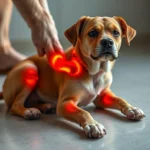
Introduction
Cryptorchidism is a condition where one or both of a dog’s testicles fail to descend into the scrotum. This issue is significant in dog health care, as it can lead to various complications if left untreated. The prevalence of retained testicles in dogs varies by breed, affecting not only the dog’s reproductive health but also its overall well-being. Addressing cryptorchidism is crucial for ensuring a healthy life for your canine companion. This article will explore the definition, causes, symptoms, diagnosis, treatment options, and preventive measures related to retained testicles in dogs.
Understanding Cryptorchidism
Definition
Cryptorchidism is characterized by the retention of one or both testicles in the abdominal cavity or inguinal canal, rather than their normal position in the scrotum. When only one testicle is affected, it is referred to as unilateral cryptorchidism; when both are retained, it is known as bilateral cryptorchidism. This condition can have significant implications for the health and behavior of dogs.
Causes
The exact causes of cryptorchidism are not entirely understood, but several factors may contribute to this condition:
- Genetic Factors: Certain breeds, such as Bulldogs and Dachshunds, have a higher incidence of retained testicles, suggesting a hereditary component.
- Environmental Influences: Factors such as exposure to endocrine-disrupting chemicals during gestation can interfere with the development of the reproductive system.
- Hormonal Imbalances: Abnormal levels of hormones during the development of the fetus may hinder the descent of the testicles into the scrotum.
Prevalence and Risk Factors
Statistics indicate that cryptorchidism occurs in approximately 1-10% of male dogs, with higher rates observed in specific breeds. Risk factors for developing retained testicles include:
- Breed: As mentioned, certain breeds are more susceptible.
- Age: Most cases are diagnosed in puppies, usually by six months of age, as testicles typically descend by this age.
Identifying Cryptorchidism
Signs and Symptoms
Identifying cryptorchidism in dogs is essential for timely intervention. Signs to look for include:
- Physical Examination: A noticeable absence of one or both testicles in the scrotum during a routine check.
- Behavioral Changes: Dogs may exhibit signs of discomfort, such as licking the groin area, or changes in behavior like increased aggression or roaming.
Diagnosis
The diagnosis of retained testicles requires a thorough veterinary examination. Key diagnostic techniques include:
- Veterinary Examinations: A veterinarian will perform a physical examination to check for the presence of testicles.
- Ultrasound: This imaging technique can help locate retained testicles within the abdomen or inguinal canal.
- Blood Tests: Hormonal tests may be conducted to understand underlying issues contributing to cryptorchidism.
Early diagnosis is crucial as it significantly impacts treatment options and outcomes.
Health Implications of Retained Testicles
Increased Risk of Health Issues
One of the most pressing concerns surrounding cryptorchidism is the increased risk of health complications. Potential issues include:
- Testicular Cancer: Dogs with retained testicles are at a higher risk of developing tumors, particularly if the testicles remain undescended into adulthood.
- Testicular Torsion: A retained testicle can become twisted, leading to severe pain and the need for immediate veterinary intervention.
- Hormonal Imbalances: Retained testicles may produce abnormal hormone levels, leading to further health issues.
Long-term health risks associated with untreated cryptorchidism make it vital for dog owners to seek veterinary advice promptly.
Behavioral Concerns
Retained testicles can also affect a dog’s behavior. Common behavioral issues include:
- Aggression: Hormonal factors related to retained testicles may lead to increased aggression in some dogs.
- Roaming: Unaltered male dogs may exhibit a tendency to roam in search of mates, increasing their risk of accidents or getting lost.
Understanding these behavioral changes is essential for dog owners to manage their dog’s needs effectively.
Treatment Options
Surgical Intervention
The most effective treatment for cryptorchidism is surgical intervention, known as orchiectomy. This procedure involves the removal of the retained testicle(s).
- Procedure Description: The surgery is typically performed under general anesthesia, with the veterinarian making an incision to locate and remove the retained testicle(s).
- Risks and Benefits: While surgery carries some risks, such as infection or complications from anesthesia, the benefits—elimination of cancer risk and resolution of behavioral issues—generally outweigh these concerns.
Non-Surgical Options
In some cases, non-surgical options may be considered:
- Hormone Therapy: Hormonal treatments may be used to stimulate the descent of the testicles, though their efficacy is debated.
- Situational Considerations: Non-surgical options may be considered in older dogs or those with significant health issues where surgery poses a higher risk.
Post-Treatment Care
Postoperative care is vital for ensuring a smooth recovery. Guidelines include:
- Rest and Recovery: Dogs should be kept calm and restricted from vigorous activity for a few weeks.
- Signs of Complications: Owners should monitor for signs of infection, swelling, or unusual behavior and consult a veterinarian if these occur.
Prevention and Management
Genetic Considerations
Preventing cryptorchidism starts with responsible breeding practices:
- Breeding Practices: Breeders should avoid pairing dogs with a history of cryptorchidism, as this condition can be hereditary.
- Selecting Breeding Pairs: It is essential to choose healthy breeding pairs free of genetic predispositions to retained testicles.
Regular Veterinary Check-ups
Routine veterinary check-ups play a crucial role in early detection:
- Routine Health Assessments: Regular visits allow vets to monitor for any signs of cryptorchidism in growing puppies.
- Discussing Reproductive Health: Pet owners should discuss any concerns related to their dog’s reproductive health during these visits.
Awareness and Education
Educating yourself about cryptorchidism is essential for proactive dog health care:
- Resources for Pet Owners: There are various resources available, including veterinary clinics and canine health organizations, that provide information on this condition.
- Advocating for Your Dog’s Health: Being informed empowers pet owners to advocate for their dog’s health needs effectively.
Conclusion
Addressing cryptorchidism in dogs is vital for ensuring their health and well-being. This condition can lead to serious complications if left untreated, making it essential for dog owners to seek veterinary advice if they suspect their dog may be affected. By maintaining awareness and engaging in proactive health care, pet owners can significantly contribute to their dog’s overall health and happiness. Understanding the implications of retained testicles and taking the necessary steps for diagnosis and treatment can lead to a healthier, more fulfilling life for your canine companion.









